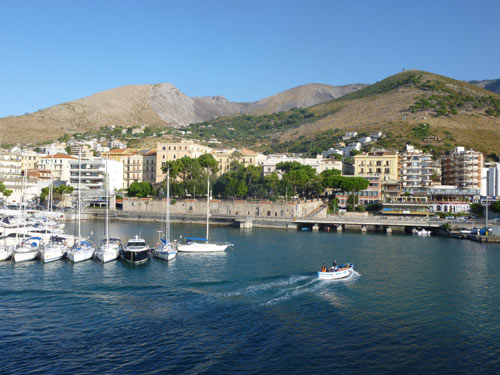The principal departure point for the Pontine islands Ponza and Ventotene, Formia isn’t an obvious tourist town, but it does have several interesting historic attractions, sandy beaches and good transport connections. If you’re catching a ferry or following the coastal road, this is a good place to stay overnight, or to base yourself while visiting other local resorts.
Unless you arrive during the Italian afternoon siesta when the world sleeps, Formia is a bustling little town filled with residents of the surrounding area driving cars, meeting up in a piazza, or shopping along the lively main street. Situated on Italy’s western coast between Rome and Naples, near the southern limit of the Lazio region, Formia is a strategic spot, though it’s overlooked by most travellers. It’s not obvious at first that this modern port town has a long and once-grand history. But if you spend a bit of time here you can visit a couple of quaint historic areas, enjoy a taste of small-town Italian life and discover some off-the-beaten-track archaeological sites. The most remarkable sight in Formia is its Cisternone Romano (‘Big Roman Cistern’), an underground reservoir testament to Roman ingenuity. Another significant ancient destination is the Tomba di Cicerone, a Roman mausoleum just outside the town which is said to have been built to honour the great Roman orator Cicero. Formia’s archaeological museum is also a must-see if you’re in the area.
> Accommodation in Formia (or read on for advice on where to stay)
> Pontine Islands tourist information and accommodation
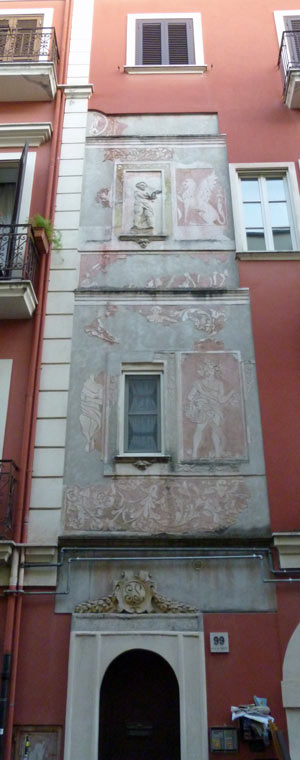
Historic and present-day Formia
For ancient Romans, the long stretch of coast between Rome and Naples was a prime leisure destination. With a mild climate – not too hot in summer, nor too cold in winter – situated on a lovely coastline and sheltered by inland hills, Formia was at the heart of a string of coastal resorts favoured by Rome’s elite. They built grand seashore villas, covering wide areas and sometimes incorporating networks of fishponds, which were both practical and status-enhancing. This was one of the most significant periods in Formia’s history. Later the town was reduced to insignificance, before a renaissance as a tourist resort in the nineteenth and early twentieth centuries, when once again Rome’s elite constructed stately villas along the coast, sometimes on top of their Roman predecessors. Another era of change occurred after the Second World War, when this strategic port was heavily bombed, resulting in severe loss of life and the near destruction of the town. Consequently, the rebuilt Formia is now a largely undistinguished modern town, sitting on top of a wealth of archaeology.
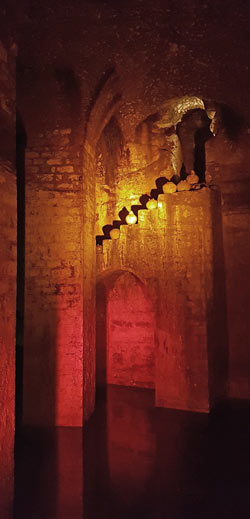
Nowadays Formia is the commercial and shopping hub for the surrounding area, and the principal departure point for the Pontine islands, with year-round ferry services to Ponza and Ventotene. It’s not a typical tourist destination, but a contented and traditional Italian provincial town. However, Formia’s location between Rome and Naples and its convenient transport connections make it a practical location to break a journey, especially if you are catching a ferry. And the town’s historic sights and archaeological museum make it worthy of an overnight stay or at least a few hours sightseeing. With beaches and easy access to other interesting destinations such as picturesque Gaeta, some travellers may consider a longer stay.
Formia sprawls along the coast, between the sea and a range of barren hills climbing inland. But the town centre is relatively compact. Although this is the sort of place where almost everyone seems to drive a car, the pavements of Formia’s main shopping street, Via Vitruvio, are busy with pedestrians out shopping or enjoying a passeggiata. The railway station is a few streets inland, uphill from Via Vitruvio, and the port is about 15 minutes walk from the station, also close to Via Vitruvio, so if you stay centrally, Formia is manageable on foot.
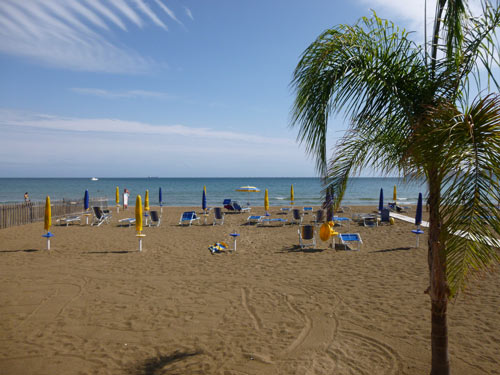
Two villages and a shopping street
In the Middle Ages, after harassment by Saracens and eclipsed by neighbouring Gaeta, the town of Formia dwindled and re-formed itself into two separate fortified settlements in the area of modern Formia. One was a village (borgo) on a hill, clustered around a military tower, the Castellone. The other, east of the modern town centre, was a fishermen’s village by another tower, the Torre di Mola. Reunited as parts of the Comune di Formia in the nineteenth century, these two tiny districts still have some historic atmosphere which is missing elsewhere in Formia. The Borgo di Castellone offers a bit of medieval hilltown charm, and the town’s most individual tourist attraction, the Cisternone Romano. There’s less to see around the Torre di Mola, but you’ll find a picturesque lane dotted with places to eat and drink which make a good evening destination. Local buses serve the town and are worth considering to save time and effort, though the distances between these sights is walkable (note that Castellone is uphill). The main shopping street, Via Vitruvio, lies between the two ‘villages’, and runs close to both of them.
The best place to begin your visit to Formia is at the town hall, the Comune. Situated on central Via Vitruvio, the building houses a tourist information point and the archaeological museum. Against the wall are plaques remembering the events of World War II, and Roman memorials mentioning the city of Formiae. Opposite is a leafy garden containing a war memorial, alongside the large open Piazza Aldo Moro, which is built over a multi-storey car park (useful if you’re driving) and is a popular place for children to play, or to admire the view out over the sea and towards Gaeta on its headland.
Museo Archeologico Nazionale
The Museo Archeologico Nazionale di Formia, the town’s archaeological museum, is small but excellent. Even if you are merely passing through Formia on a driving tour, I’d encourage you to stop and pop in to see the museum’s marvellous little collection of high-quality Roman sculptures (with a car park over the road and fairly standard opening times, this should be easy to plan). Highlights of the museum include three beautiful male nude statues, larger than life size, which were found, like many of the exhibits, in the area of modern-day Piazza Mattei, once the Roman Forum. Busts of Augustus and Livia, a trio of headless robed maidens and a striking double-faced Apollo are among the other stand-out pieces. A map at the entrance provides an overview of the town in Roman times and the statues here, along with fragments of wall decoration, help to give an impression of the elegance and luxury of Roman Formiae and its villas. The museum is small, so you can see and appreciate its contents quickly without being overwhelmed. There’s a small admission fee, and at the time of writing the museum is open daily with standard opening times (but check ahead).
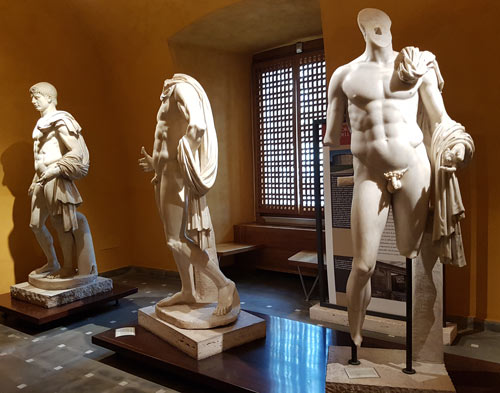
Cisternone Romano
The Cisternone Romano (Roman Cistern) is Formia’s most interesting and unusual tourist sight. A huge underground water reservoir constructed in ancient times, it can be visited on tours and is unmissable if you’re in the area. Opening times and days vary through the year, and it’s advisable to check in advance and plan around these. Occasionally cultural events are held here.
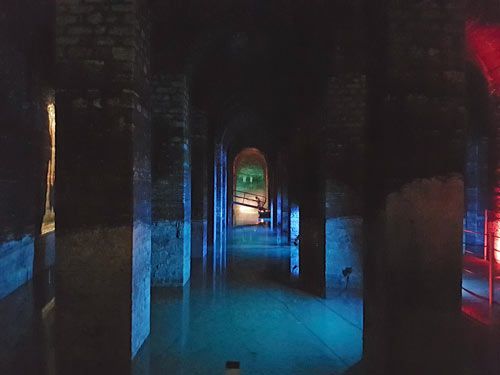
Situated under the Borgo di Castellone, the cistern consists of a very large cavern excavated by the Romans in the 1st century BC, with a roof supported by columns. Six metres high and sixty metres long, the reservoir collected water from hillside springs for distribution to the surrounding area, including the grand villas by the sea with their systems of fishpools which required fresh as well as salt water. Ironically modern-day Formia has had water shortage problems despite this history of being, as residents put it “a town built on water”.
The entrance to the Cisternone is set just below a small open square surrounded by medieval lanes; once you enter you will learn that this square and nearby buildings are all built above Formia’s great secret. Descending a long stairway, you emerge into a huge cathedral-like space, where a wooden walkway has been built for visitors. There is still shallow water in the cistern, adding to the atmosphere, though the original water line would have been far above modern-day visitors’ heads. It’s a remarkable and atmospheric experience.
Practicalities of visiting: If you are thinking of visiting Formia you should absolutely try to plan around the Cisternone’s opening times. More details are below. At the time of writing tours take place on Saturday and Sunday evenings in winter, and more frequently in summer.
Tomba di Cicerone
Just outside Formia, in a countryside setting next to the ancient Appian Way (now the SS 7 Appia), is another unique sight of which Formia is justifiably proud. The Tomba di Cicerone, or Tomb of Cicero, is a Roman mausoleum standing in its original walled enclosure. Not often open to the public, but viewable from the roadside, this well-preserved tower is said to be the mausoleum of Roman orator Cicero. A persuasive case is made locally for this identification: Cicero certainly had a villa in the vicinity of Formia (one local theory is that he owned this particular stretch of land); a far more ruinous mausoleum on the hillside nearby is identified as a monument to his beloved daughter Tullia; he was killed in this area in 43BC while attempting to flee Italy, tracked down by assassins sent from Rome.
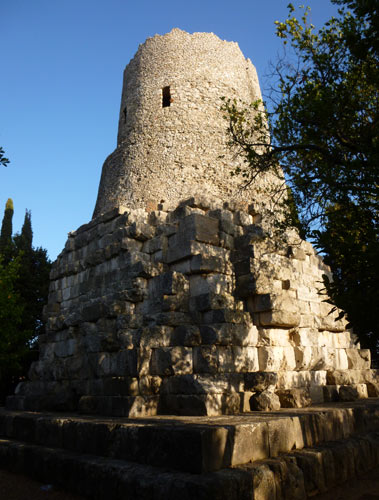
The ruined mausoleum consists of a 24m-high round tower on a square base of large stone blocks. Once this would probably have been crowned with a statue; later apparently replaced by a giant sphere and later again by an angel. An entrance in the base leads into a small but high brick-walled interior, once decorated with marble and statues. A central column supports a domed ceiling.Outside, a rough stepped route up the stone blocks leads to a small door in the upper tower, originally providing access for maintenance. The green and leafy enclosure around the tower provides an atmospheric setting. Most of the enclosing walls date back to the Roman era, with a few bits reconstructed; look out for the clever sloped coping which directs rainwater out away from the brickwork. In a field alongside are some beehives, producing (of course) “Cicero’s Honey”.The site has had a colourful and romantic history over the centuries, said at one point to have been a brigands’ lair.
At the time of writing the tomb is rarely open, though there are occasional public tours and cultural events held here, including classical concerts. When visiting Formia, check the latest opening information. You can get a decent view of the tower and its enclosure without actually entering the site; it is right alongside the road, with only a low metal fence as a barrier. There’s no official parking, but there’s a narrow lane opposite with room for a few parked cars. If you have set your heart on visiting the site, but don’t have your own transport, I’d recommend arranging a taxi or a lift from Formia. Although it isn’t far outside town, the road isn’t pedestrian-friendly. It is possible to glimpse the mausoleum from the Rome-Naples railway line, on the seawards side of the tracks alongside the road just before you reach Formia. It’s also visible on Google Streetview, where you can check out the route from town if you want to judge for yourself how walkable the road is.
More things to see and do
The sharp-eyed visitor will come across other remnants of Formia’s ancient past while exploring the city: a glimpse of forum walls behind a glass wall, a column standing near the road, bits of low ruined walls. Beneath the pretty little Villa Comunale park is a row of arches: the cryptoporticus of a first-century-BC Roman villa. The fishponds of this villa can be seen in the sea nearby at low tide. The ruins of another grand villa, traditionally known as ‘Cicero’s Villa’, are now incorporated into the grounds of Villa Rubino, once a holiday home of Bourbon royalty. Villa Rubino isn’t visitable at the time of writing, but it’s worth keeping your eyes open when visiting Formia in case of any public openings or events at this or other local Roman sites.
On the quest for more antiquities as well as natural beauty, visitors with cars may be interested in visiting the Parco di Gianola, a coastal and hillside reserve just east of Formia, where you’ll find footpaths, a ruined Roman villa and a Roman harbour. Other sights in the area include the hills behind Formia, the Monti Aurunci (another natural park), where footpaths include the Sentiero del Redentore, a walk to a cave shrine and a statue of the Redeemer, il Redentore. Close to the boundary of the park is the medieval hill village of Maranola (pronounced MaRAnola), which is reachable by public bus from Formia.
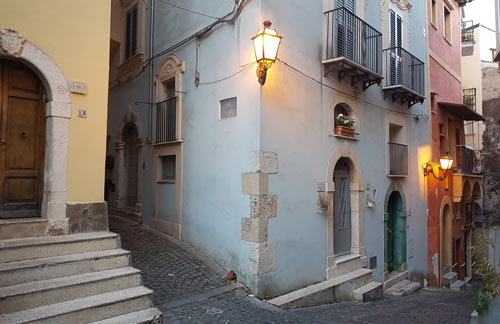
The centre of Formia has, since its post-WW2 rebuilding, been separated from the sea and its port by a wide and ugly coast road. But a short distance on either side of the centre there are beaches and more of a seaside atmosphere. To the west of town and reachable on foot by walking westwards up Via Vitruvio then taking Via Tonetti on the left, is a little park beneath pine trees, with a bar and stone loungers facing the sea, called the Pineta di Vindicio. Beyond this is a long stretch of sandy beach, the Spiaggia di Vindicio, with jaunty beach establishments renting out sun-loungers, and also stretches of free public beach. There’s a lovely view towards Gaeta and a laid-back holiday vibe which contrasts with the bustle of Formia’s shopping hub. On the other side of the Pineta is the Porticciolo Romano di Caposele, a little harbour which is Roman in origin. Alongside is an archaeological site (generally closed) and on the far side of the harbour, though not visitable, is Villa Rubino, described above.
Shopping is one of Formia’s most conspicuous activities, and there is a lively shopping scene along Via Vitruvio. Visitors will find Italian chains, small clothes boutiques, cafés and take-aways. If you’re heading to the Pontine islands, this is an opportunity to purchase holiday clothing and essentials at normal mainland prices. Food is another good thing to buy here. Around Via Rubino and Piazza Marconi are a number of tempting food shops including specialities such as provolone cheese at the Recco Bottega del Formaggio. On Via Vitruvio is the Pasticceria Troiano, where you can buy delicious Dolci di Cicerone, little pastries named after Cicero and inspired by Roman recipes – an ideal souvenir of the town. As Formia doesn’t have many tourists, its businesses are firmly aimed at locals, with decent local prices and friendly service.
In the evening, to eat in a more atmospheric environment, head to one of the two old centres, Castellone or down near the sea on Via Tullia/Via Abate Tosti. There are a few bars and restaurants along the latter street, and its a nice area to spend some time. The Enoteca Telaro (Via Tullia) is a classy wine bar with a bottle-lined interior, where you help yourself from generous trays of aperitivi snacks in the early evening. Wines to try include Falanghina, which is made in this area. For a cheap pizza to eat in or take away, try the popular Pizzeria del Secolo (Via Vitruvio 45) – you might have to wait to get served, but pizza slices are delicious.
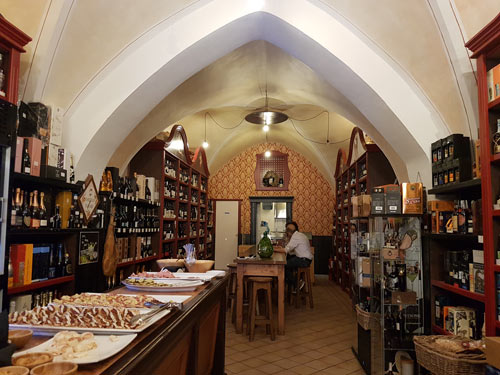
A note on visiting Formia
Although it rarely features on tourist itineraries, Formia is keen to welcome visitors. Several of the town’s archaeological sights are managed by associations led by volunteers. They do their best to keep the town’s history in the public eye, to preserve its archaeological sites, and to make them accessible to the public as much as possible. Before visiting, I would recommend checking the latest opening dates and times online, and consider getting in touch using online booking, email or phone to book or arrange visits. A good starting point is the website of Sinus Formianus or Formia Turismo. At the time of writing there are tours of the Roman sites including the Tomba di Cicerone one Sunday every month and the Cisternone Romano is open a couple of times a week (more often in summer, English tours available on request). If seeing the Tomb of Cicero is important to you, consider driving, taxi-ing or even walk there, and you can get a reasonable impression from the roadside even without entering the enclosure.
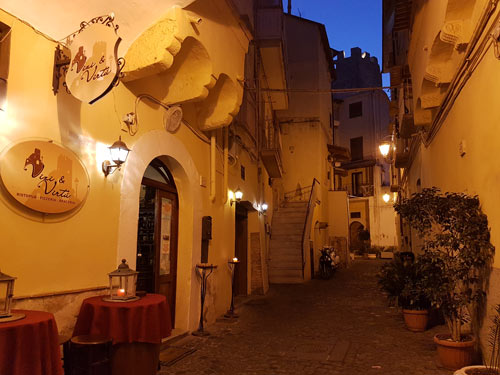
Around Formia
Formia is close to picturesque Gaeta, which sits on a headland at the edge of the same large bay. Gaeta is better known as a tourist resort than Formia, and is well worth a visit when you’re in the area. Formia station is officially known as Formia-Gaeta and serves both towns, though it’s in the centre of Formia. Frequent public buses connect Formia and Gaeta; travellers relying on public transport may find it easier to stay in Formia if planning to visit both towns.
Other excursions from Formia include Ponza – although the island merits more time, it can be visited in a day trip, subject to ferry schedules and sea conditions. Lovely white-painted Sperlonga and its Roman villa-grotto can be reached by train, requiring a bus connection from Fondi-Sperlonga station to Sperlonga.
Where to stay in Formia
The best central choices in Formia are small B&Bs. I spent a couple of nights at Dall’Architetto, a B&B on Via Vitruvio with three guest rooms in an architect’s studio – a very convenient choice. Check the location on the map provided when booking accommodation in Formia, as the town spreads out a long way, and some hotels will be more convenient to travellers with cars than to public transport users. In the most central area, there’s a limited choice of a few B&Bs, so book ahead. Other appealing options include Hotel Castello Miramare, a castellated historic villa on the slopes above town, Hotel Tirreno, a beach hotel a couple of miles south of the port, and Domus Cicerone, another B&B in a good central location.
> Formia hotels, B&Bs and apartments
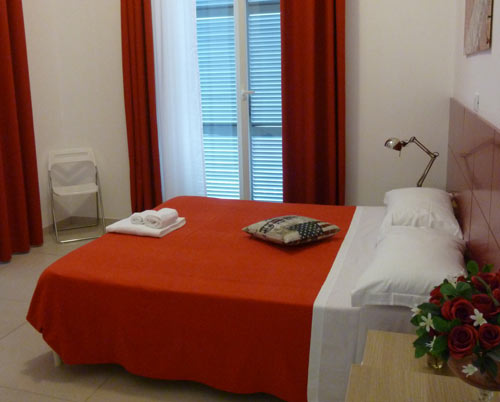
Travel to Formia
Formia is on the old Roman Appian Way heading south from Rome, and can still be reached following the old route from Terracina inland via Fondi (now the SS 7), though now there is a coastal road too. From the Rome-Naples Autostrada (A1) take the exits for Frosinone or Cassino.
The easiest way to arrive by public transport is to take the train. Formia-Gaeta station is on the main railway line heading south from Rome to Naples. The fastest trains don’t stop here, but travellers have a choice of Regionale (slow and cheap) and Intercity services (faster, more comfortable, pricier) – make sure you have the correct ticket for your train. Journey time from Naples is around 50 minutes by Intercity train, and from Rome 65 minutes. If you’re flying, Naples airport is marginally more convenient than Rome, since the airport-railway station interchange is quicker, and the train journey a little shorter. Buses connect Formia with Gaeta, Terracina and other local destinations. Most are operated by Cotral and stop in Piazza Mattei and by the port at Piazzale Vespucci (buy tickets beforehand at the ticket office, news-stands or a tabaccaio; more local services are run by ATP (see links panel).
Getting from the station to the port in Formia
These directions refer to the Molo Azzurra in Formia, where Pontine island ferries moor at the time of writing, at the Banchina Azzurra by Via Tallini. There are ticket offices here. Note that there has been talk of moving ferries to the other side of the port; check the ‘Biglietterie’ or ”Dove siamo’‘ links on the ferry websites when you’re researching timetables to be sure you end up in the right place.
The station and the port in Formia are within walking distance of each other (around 15 minutes), although the station is above sea level, and the most direct route involves steps. In the past there has been a free shuttle bus (navetta) between port and station, which I’ve even glimpsed once; if you ask locally you may find out more. Allow a generous amount of time for an interchange, as neither trains nor ferries will necessarily arrive on time. Check the ferry company website for departure details, as there has been talk of shifting the ferry terminal.
If you’re travelling light and happy with steps, simply head down the broad flight of stairs opposite the station, turn left on Via Lavanga, right down Via XX Settembre, then left on Via Vitruvio where you can pick up the route below. For a step-free route, you’ll need to take a short detour. The best way I’ve found is described below; I’ve walked it in both directions pulling a suitcase; however it would certainly be more comfortable to catch a taxi, particularly for the uphill route from the port to the station. You’ll probably be able to find a taxi on arrival; there is a kiosk providing tourist services at the port including left-luggage; this might be a good place to ask.Directions: as you emerge from the front of the station, turn right and follow Via XXIV Maggio downhill. Follow it around to the left, and continue downhill until you reach Via Vitruvio. Turn left and follow Via Vitruvio until you reach a flyover heading to the right, towards the sea. Walk over this flyover (unfortunately the pavement is narrow) and at its foot you’ll reach the ferry port.
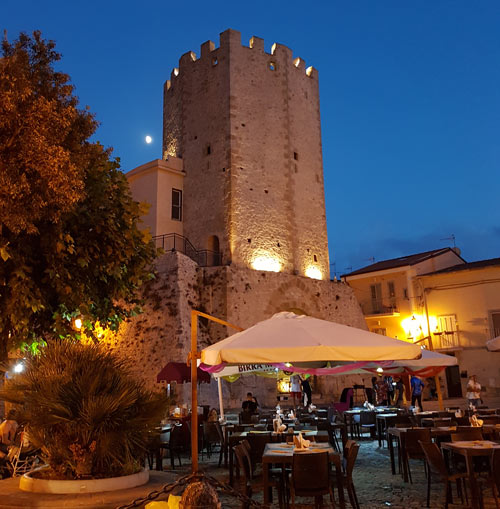
On this site
Useful external links
Museo Archeologico Nazionale di Formia
Parco Naturale dei Monti Aurunci
Lazio destinations
- About the Lazio region
- Anzio
- Bracciano
- Calcata
- Castel Gandolfo
- Castelli Romani
- Cerveteri
- Formia
- Frascati
- Gaeta
- Palestrina
- Pontine islands
- Ponza
- Rome
- Sperlonga
- Terracina
- Tivoli
- Ventotene
- Viterbo
